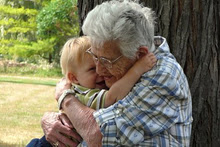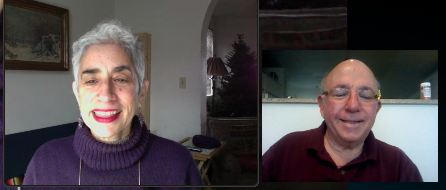Sunday
Community ArticlesA Conversation on Aging
 This is the second is a series of articles on Aging in Shambhala. Read the first article if you missed it: Aging in Englightened Society.
This is the second is a series of articles on Aging in Shambhala. Read the first article if you missed it: Aging in Englightened Society.
—
A Statement on Aging was adopted by the Shambhala Congress held in November 2009. That document (click here to read it) was intended to provide a basis for continued conversation among Shambhalians. In the following article, the co-chairs of the Shambhala Working Group on Aging (Andrea Sherman and David Whitehorn) share their views on key points in the statement. The conversation took place through the medium of skype since Andrea lives in New York and Dave lives in Halifax.
Dave: For me the key to the statement is the first item, which states: The inherent nature of mind, basic goodness, being unconditional, does not change with age. No matter how old or infirm we may become, basic goodness remains fully intact.
In the two years since the Statement on Aging was written, the central role of basic goodness in the Shambhala teachings has become increasingly evident. The first item in the statement particularly emphasizes that basic goodness, the inherent wisdom, kindness, and strength that infuses all mental experience, does not change with age. From that point of view, the experience of basic goodness is available to everyone, regardless of age. Aging, of course, is occurring throughout the life span, from birth on through to death. A lot is changing with age, physically and mentally. But the unchanging presence of basic goodness, the inherent qualities of awareness, always provides a point of reference, whether we are a crying baby, a stressed-out young adult or a frail elder. We all share that common heritage.
Andrea: Yes, for me the concept of basic goodness and its unchanging nature as we age is important. I would add to that the important connection we gain to a sense of worthiness as we grow older, and the importance of cultivating a sense of worthiness throughout our life. It is easy to lose confidence as we age, so along with basic goodness, we must generate tenderness towards our self, along with a healthy dose of kindness and gentleness. Thinking of basic goodness in relation to our potential, cheerfulness, and experience of joy can help to provide a sense of purpose, meaning, and humor through the experiences of “falling apart” that can happen as we age.
Dave: It’s interesting that you point out the “falling apart” aspect of aging. In the 2009 statement the most controversial item was number 3: Physical and mental capacities inevitably decline with increasing age. We got a lot of flack on that one, with people citing someone they knew who was 95 years old and had a perfect memory, or ran marathons, things like that. My own experience at age 70 is that there is no doubt that certain aspects of my physical and mental capacities are declining. On the other hand, it feels to me that I do have a somewhat better grasp on how my mind works and how life unfolds than I did at younger ages. But who knows, I could be wrong about that.
Andrea: Perhaps the statement could read: Physical and mental capacities can decline with increasing age. Part of the challenge here is that for so long aging has been thought of as a problem, and a disease. We are in the middle of a historical “sea change” where we are not denying the problems and challenges of aging, but shifting our thinking from a deficits-approach to a strengths-based approach, and an awareness of the potential and desire for meaningful and purposeful engagement.
This relates to the second item: Rather than viewing aging as leading to the fixation of long standing habitual patterns, with mind training (meditation practice), as we grow older there is the opportunity for mind to become more open and less fixed.
This is good news for Shambhalians: meditation can provide an opportunity for clarity as we age.
Dave: Clarity and also learning. Being a Shambhala practitioner means being on a path, being involved in an ongoing process. Everything we encounter is an opportunity for learning, and for deepening our understanding of our own mind and the world. From that point of view, aging, including becoming frail and at some point dying, is a further opportunity to “bring all experiences to the path.”
We also use the image of the warrior to represent the Shambhala path. One aspect of being a warrior is that a warrior doesn’t expect things to go smoothly all the time. In fact, a warrior trains so that they can step forward into difficult and even dangerous situations and act effectively, and in the case of a Shambhala warrior, act compassionately. My sense is that we need to emphasize that getting old, becoming frail and dying are not at all signs of failure or defeat. They are simply further opportunity for training and for manifesting, to the extent we can, enlightened warriorship. It is important, as well, to keep in mind that in the Shambhala lineage we do not consider death to be the end of the path. Some kind of awareness is said to continue beyond death, and so the training continues as well.
Andrea: Excellent! It’s interesting that aging has been described as a landscape without a map, and that the process of growing older is considered to be “betwixt and between” and has a “bardo” quality to it. One friend described growing older as the “bardo of chronic pain.” This journey of warriorship as we age, whether we are dealing with pain, loss of control, and whatever else may arise, challenges us to see the vastness of our aging processes. Approaching it with a sense of spaciousness, curiosity, and relaxation can provide ease. The teaching of ziji can also be inspirational — to age full of splendor and confidence — to be able to experience and appreciate the sacredness of our world, joyously and with celebration…And of course, cultivating a sense of humor along the way!
Dave: And then there is the practicality of caring for self and others when the aging process gets to the point where you actually need help. The final item in the Statement on Aging states: As we age many of us will, at some point, experience physical ailments that will make it difficult, or perhaps impossible, for us to care for ourselves. At those times, other members of Shambhala society need to be positioned to come forward to be sure that what we are unable to do for ourselves is done.
This was intended as a “place marker” to indicate that we need to organize ourselves in order to be able to get help to the people who need it in a timely and effective manner. I think of this as very much related to the Sakyong’s increasing emphasis on Shambhala as social transformation. How do we actually get people working together to care for one another? Doing so is a social experiment.
This obviously goes beyond our individual relationship to aging and calls upon us to form a social system that is consistent with the deepest understandings of basic goodness both at the individual and societal levels. Given that so many Shambhala warriors, most with a considerable degree of training, will be experiencing old age and death over the next several decades it would seem a very fertile focal point for the ongoing process of creating enlightened society. Perhaps an evolving Statement of Aging can be a catalyst in that process.
—
Contributions to the monthly column, “Aging in an Enlightened Society” are welcome. Please contact Andrea Sherman at: [email protected]






May 13, 2012
Reply
I would like to share my gratitude to the Shambhala community and all those who are dealing with this subject. I’m working at this moment with a project in a public library in Brazil in which we are developing new services to the elders. What we discovered is that the project isn’t just about creating new services but also about changing the way our society views this time of life that we will all facing at some point.What we are really doing is beginning a movement to give a new meaning growing old. So, this debate inspired me more. Thank you!